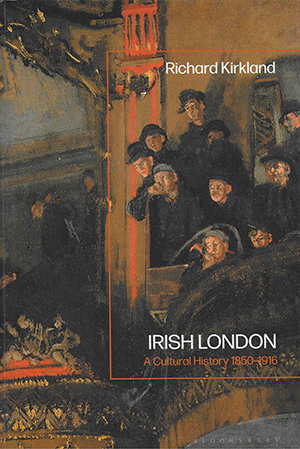IRISH LONDON: A CULTURAL HISTORY 1850–1916
Published in Book Reviews, Book Reviews, Issue 1 (January/February 2022), Reviews, Volume 30 RICHARD KIRKLAND
RICHARD KIRKLAND
Bloomsbury
£85
ISBN 9781350133181
Reviewed by Angus Mitchell
Angus Mitchell is a historian and lives in Limerick.
In his contribution to Glór Ulladh 1893–1943, the Belfast singer and writer Cathal O’Byrne remembered:
‘When we went to London to give a series of folk-song recitals, we were the honoured guests of a dinner party given by Mrs Green, at her beautiful house in Westminster, overlooking the Thames, a house that was the cultural centre for authors, poets, writers, musicians, politicians and people of literary and social distinction of every country and every grade whatever.’
Such reminiscences crystalise that free flow of people, ideas and melodies in the formation of counter-spaces that were integral to Irish-Ireland’s diasporic reorganisation after the devastating years of hunger and exile. The salon of Alice Stopford Green opened one such space where social, racial and gender divides were crossed, and Irish culture was revived and mobilised for political ends.
Another unremembered Irish salon circulated through the Hampstead home of Robert and Sylvia Lynd. A decade or so ago, three generations of Lynd family papers were sold through an antiquarian book dealer in London. They attested to over a century of dedicated service to various causes: Irish republicanism, British communism, literary modernism, internationalism and human rights advocacy. That fragmentation of the Lynd archive serves as a metaphor for the broader shattering of the intellectual contribution of the Irish to global movements. London was as much a centre for cultural revival as either Dublin or Belfast, but that dimension has been largely lost in the labyrinthine paths leading to the GPO.
Early on in his monograph Kirkland maps the desperate social adversities faced by the Irish in London. Here he relies on M.A.G. Ó Tuathaigh’s seminal essay ‘The Irish in nineteenth-century Britain: problems of integration’. His opening chapter sketches the St Giles Rookery, known as ‘Little Ireland’ and regarded as the most deprived slum in early Victorian England. Out of that cauldron of social exclusion came the 1880s Fenian bombing campaign and the advent of another strand of agency and activism. Subsequent chapters in Irish London draw out the place of the metropolitan centre in the formation of this new sense of Irishness, forged in often desperately hostile circumstances. Kirkland is good on the Southwark Literary Society but is poor on nuancing the place of women, and especially New Women.
There is no mention of the pioneer of the Irish Arts and Crafts movement, Evelyn Gleeson, secretary of the Irish Literary Society, nor of N.F. Dryhurst, a key figure within anarchist, socialist and nationalist coteries and part of the William Morris circle of the 1880s. Also missing in action is any trace of the recently recovered life of Hannah Lynch 1859–1904: Irish writer, cosmopolitan, New Woman, who was secretary of the London branch of the Ladies’ Land League and the subject of an excellent recent biography by Faith Binckes and Kathryn Laing (Cork University Press, 2019). Kirkland makes nothing of the experimental community of Bedford Park, a critical hub in the urban geography of Irish London in the early 1890s. There the Yeats household mixed with fascinating influencers such as Madame Blavatsky and Frederick York Powell, regius professor of history at Oxford, who spent most of his time in London. York Powell was instrumental in the establishment of the Irish Texts Society and in bridging dialogue around folklore and theosophy among the Celtic Revivalists.
This exclusion of recent scholarship that re-evaluates the politics of the age and emphasises innovative intersections between women’s rights activism, socialism and peace advocacy is a significant fault line in Kirkland’s analysis. Another missing dimension is Ireland’s place within the gathering tide of anti-imperialism in the metropolitan centre. These elisions are buttressed by disfiguring readings or misreadings of key protagonists and their topographies. The current work on network theory and ‘intersectionality’ might have provided clearer recognition of both horizontal and vertical forms of resistance and the overlaps between élites and mass mobilisations of dissent. How did Irish London a/effect change with the tectonic eruptions across the British Empire? Analysis of these broader and emerging contexts would have sharpened up this study significantly.
Kirkland’s style is easy and accessible, but for those who have Irish the best book on the Gaelic League in London remains Donncha Ó Súilleabhain’s Conradh na Gaeilge i Londain, which captures the subaltern narrative and the extraordinary reserves of dedication and voluntary service that drove many Irish souls to sacrifice their lives in cold, damp and smoggy circumstances for a political reckoning that lay far in the future. One must ask why Kirkland’s study ends in 1916 and the tragic demise of Dora Sigerson. Surely it is worth including the crowds of London Irish who protested loudly and defiantly around Parliament Square and Whitehall during the War of Independence as exclusionary discussions happened behind closed doors?
On 12 July 1921, when the Irish peace delegation arrived by train at Euston to begin the negotiations leading to the signing of the Articles of Agreement, they found thousands of loyal supporters gathered on the platform to welcome them. Organisations such as the Peace with Ireland Council and the Irish Self-Determination League demonstrated how years of patient and sacrificial grind had mobilised a community that could exert vital pressure from both above and below. Irish independence was won as much on the streets and salons of London as it was in the remote backlands of Munster or the backstreets of Dublin. But much of that story isn’t yet told.
















